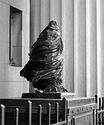Now that spring is coming in full force, I've started shootin my stash of HIE again. Oh, how I wish it was still available. I love the grain, the extended IR sensitivity, the general high speed, and the lack of an anti-halation layer.
So HIE has been unavailable for a while. What have people settled on as a decent replacement? I wonder what the interest would be for a similar product from another manufacturer. Or the feasibility of that ever happening. I'd love it if Ilford came out with a high speed, extended IR film with no anti-halation layer.
A semi related question to PE or someone else. Why does HIE have such a big dip in sensitivity around 520 nm?
So HIE has been unavailable for a while. What have people settled on as a decent replacement? I wonder what the interest would be for a similar product from another manufacturer. Or the feasibility of that ever happening. I'd love it if Ilford came out with a high speed, extended IR film with no anti-halation layer.
A semi related question to PE or someone else. Why does HIE have such a big dip in sensitivity around 520 nm?








